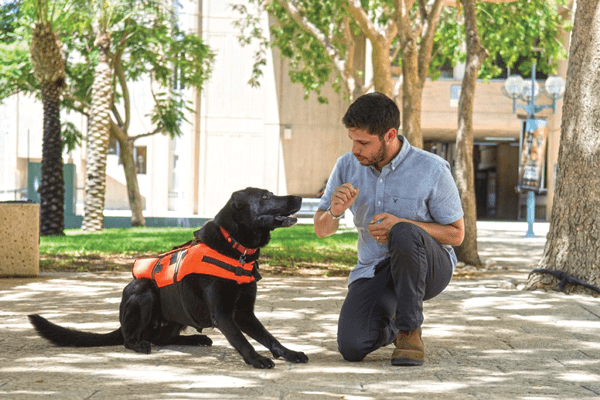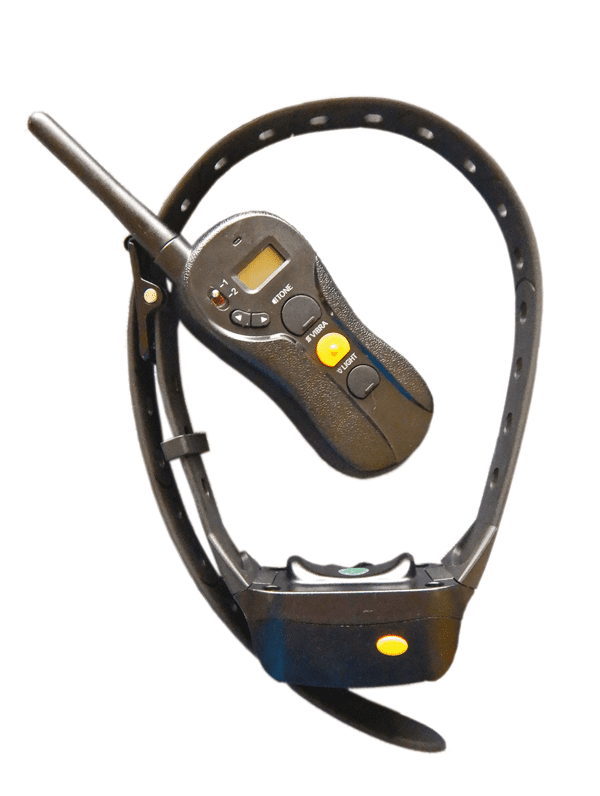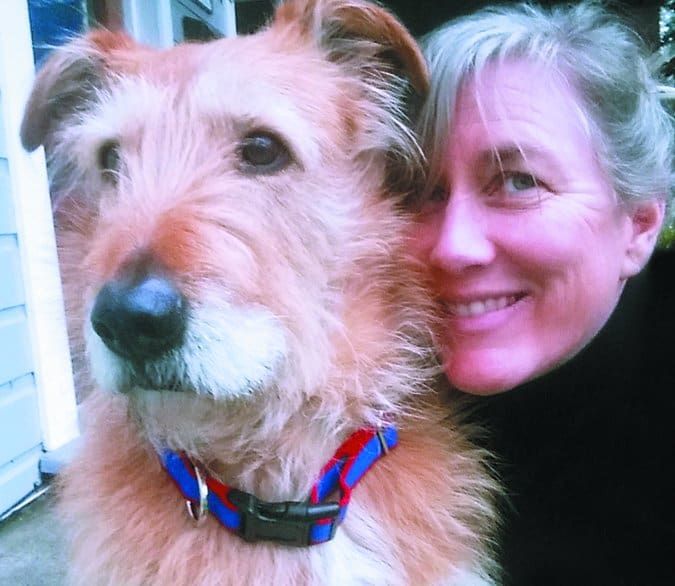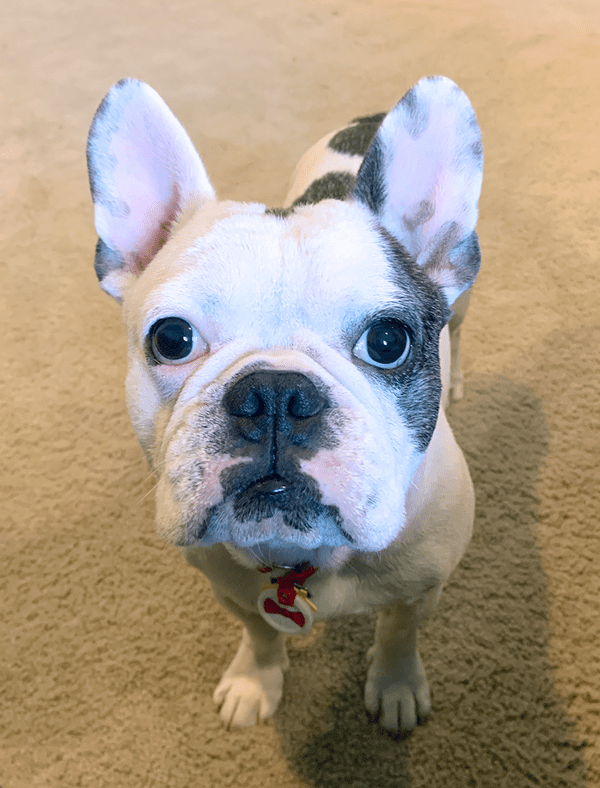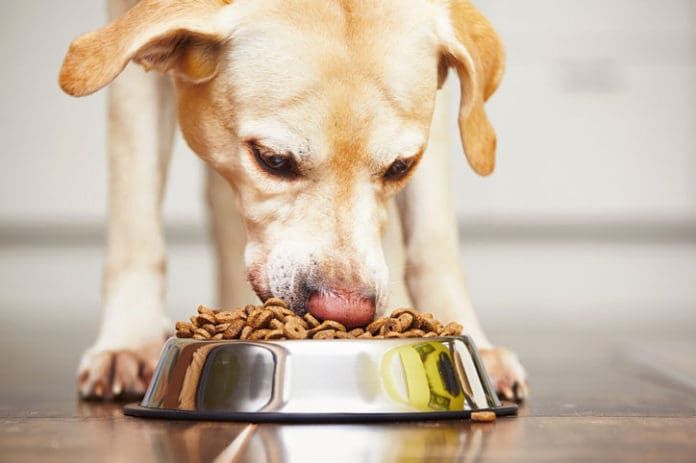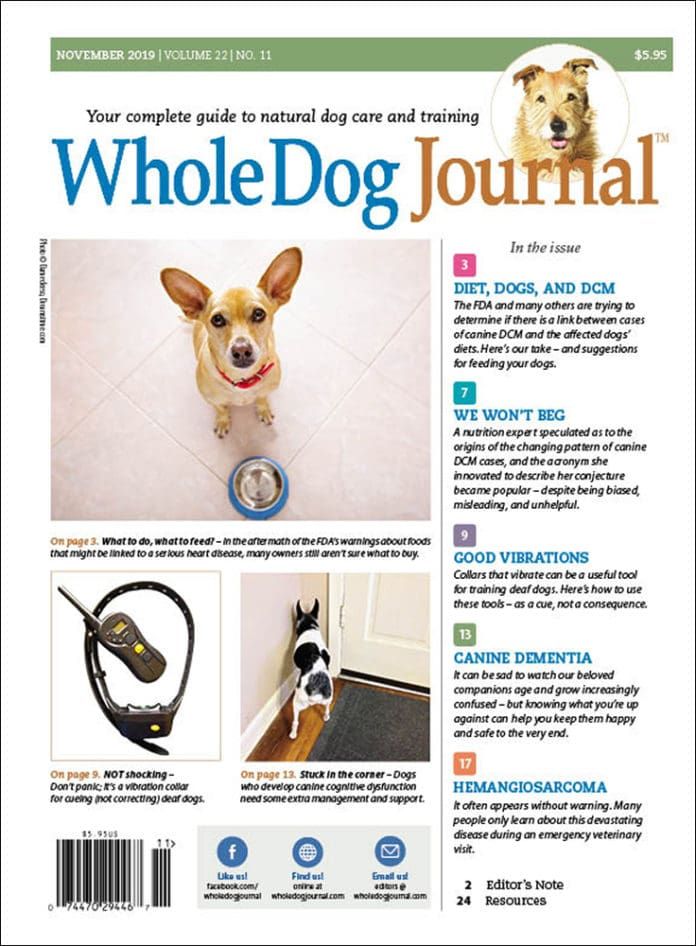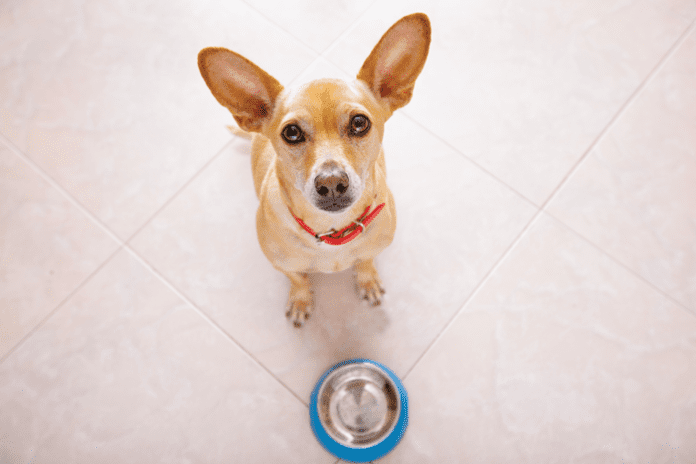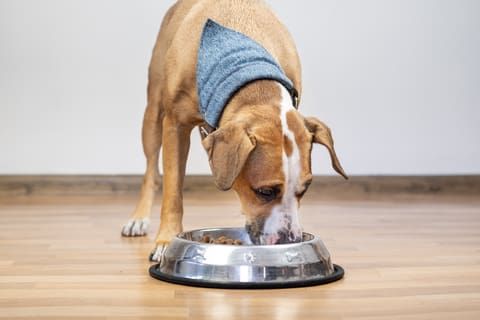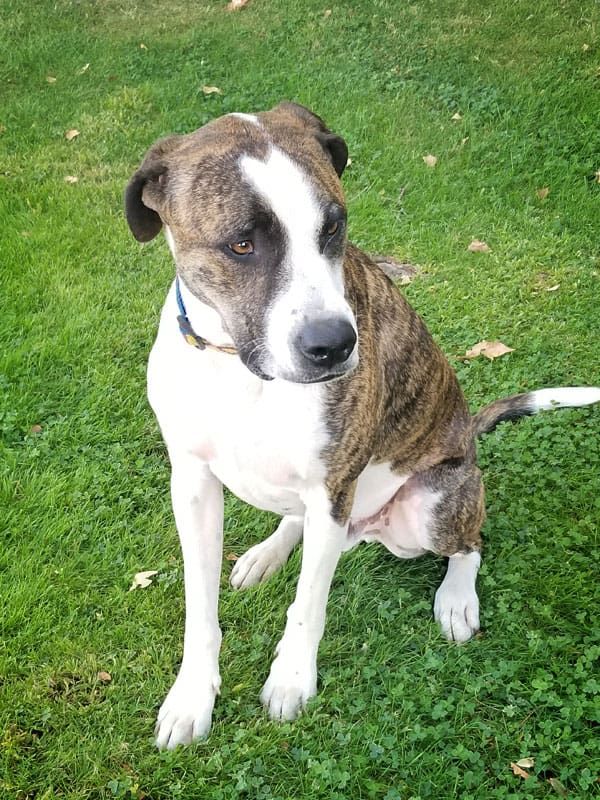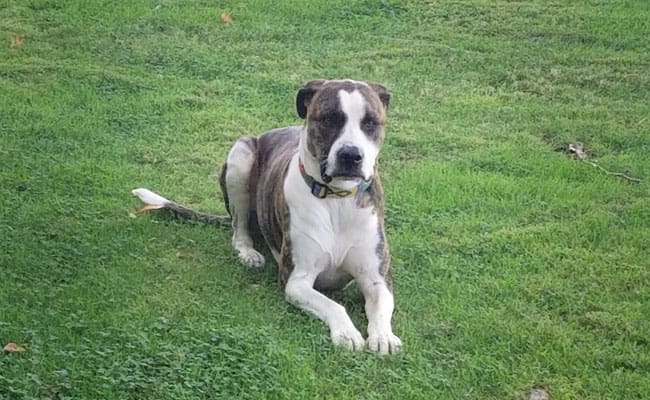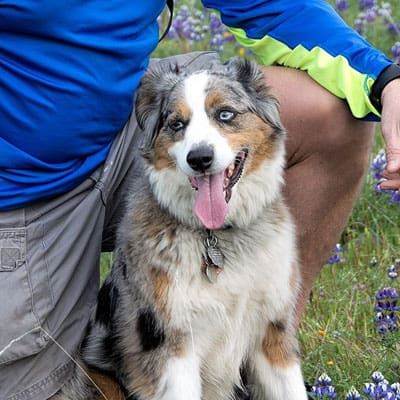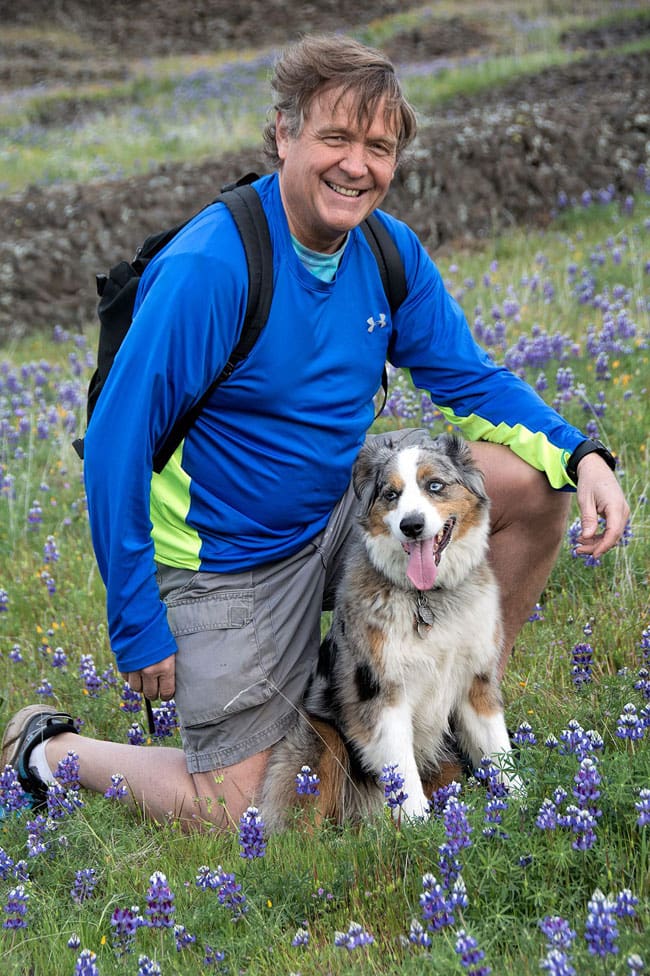Food reviews have been a standard feature of WDJ for 22 years, so it’s not a surprise we are asked for dog food recommendations. The inquiries multiply whenever there is any bad news about dog food – and the ongoing mystery about a possible connection between dog diets and a serious heart disease, canine dilated cardiomyopathy (DCM), is definitely bad news.
Depending upon which news outlets you follow, you may be worried about feeding your dog a food that is grain-free, one that contains peas or other legumes, or one that is “boutique” or made with “exotic” ingredients.
If you haven’t been following any of the news, you can catch up by reading our in-depth article by nutrition writer Linda P. Case in the September 2018 issue (“The Heart of the Matter”) and the blog posts on August 2, 2018 (“Please Don’t Panic About the Grain-Free Thing”), August 9, 2018 (“Choosing Dog Foods After The Grain-Free Scare”) and July 16, 2019 (“Update on grain-free diets and DCM cases in dogs”). Suffice to say here that in July 2018, the United States Food & Drug Administration (FDA) announced that it was looking into reports of a possible link between DCM in breeds of dogs that are not considered at genetic risk of the disease and diets containing “peas, lentils, other legume seeds, or potatoes as main ingredients.”
A year later, the FDA published an update to its original announcement, which included detailed data about the cases they were investigating but still offered no guidance regarding how owners could feed their dogs in order to protect them from developing DCM.
We have been analyzing the data that has been released about the diets that were named in the 515 reports being investigated by the FDA. From this analysis, we have developed recommendations that can help you make feeding choices that we believe could protect your dogs from this disease. In the online version of this article, we have included links that will take you to more detailed explanations, should you wish to know more about how we came to our conclusions.
Before we go on, though, please note: Anything you read, including here and in articles written by veterinary nutritionists, is conjecture. No one knows for sure what might explain a link between certain types of diets and DCM in some dogs – or whether there even is a link – although we believe there is.
Is Your Dog at Risk?
It’s important to keep in mind that the vast majority of dogs who are fed the diets named in the FDA’s reports do not develop DCM! On the other hand, we know that there are more cases of DCM than those that have been reported (or even diagnosed). So how concerned should you be?
The risk of diet-related DCM is not the same for all dogs. Certain breeds of dogs (or lines within breeds) are susceptible to DCM due to taurine insufficiency, where the amount of taurine (or its precursors, methionine and cysteine) in the diet is enough for most dogs, but not for them. These breeds include the American Cocker Spaniel, English Setter, Golden Retriever, Labrador Retriever, Newfoundland, and Saint Bernard. If your dog belongs to one of these breeds, then you should be more concerned about what you’re feeding than the average pet owner.
[post-sticky note-id=’404562′]
Other breeds are genetically prone to DCM that is not linked to taurine deficiency, including Boxers, Doberman Pinschers, Great Danes, and Irish Wolfhounds. These dogs may be at no greater risk of diet-related DCM, but since we don’t know for sure, owners may want to be more cautious with these breeds than with others.
Large and giant breed dogs are more susceptible to DCM than smaller dogs are. If you have a large dog, you should be more concerned about what you feed than those with small dogs. One of the factors that drew the attention of veterinary cardiologists, however, was seeing DCM in some smaller dogs as well, so even people with small to medium dogs may want to take precautions. Dogs who eat less than would be expected for their size (older or inactive dogs, or those who get too many calories from treats) also may be at increased risk of dietary insufficiencies, including taurine, which might help explain why some small dogs are affected.
Another risk factor is dogs who eat the same food for long periods of time. The initial FDA report stated, “Early reports from the veterinary cardiology community indicate that the dogs consistently ate these foods as their primary source of nutrition for time periods ranging from months to years [emphasis ours].”
The longer you feed the same food, the more likely your dog is to be affected by any nutritional deficiencies or excesses it contains. Those who rotate foods regularly, particularly those who rotate between different brands of foods with different primary ingredients, have less cause for concern than those who always feed the same food to their dogs.
Focus on Taurine
All of our recommendations are based on the assumption that the issue linking diet and DCM is related to taurine deficiency. There are two very good reasons for this. The first is the link between taurine and DCM in cats that was discovered in the 1980s. The second is the link between taurine and DCM in certain dogs being fed lamb and rice diets that first came to light in the 1990s. Because we know that a lack of sufficient taurine or its precursors can cause DCM in otherwise healthy dogs of all breeds and mixed breeds, it appears to be the most likely culprit in this current situation.
Some of the affected dogs in the FDA reports were found to have low blood taurine levels; however, the majority have normal blood taurine levels. Despite this, most dogs diagnosed with what is suspected to be diet-related DCM are given taurine supplementation, regardless of their taurine blood levels, as well as being switched to a different diet and prescribed heart medications. Some dogs improve, others do not. At this time, it’s impossible to know which factors lead to improvement and which are unnecessary.
Until we know more, our recommendations center on avoiding taurine deficiency by increasing the bioavailability of taurine and its precursors, even for dogs who do not appear to be taurine-deficient.
In general, we recommend avoiding the potential at-risk food categories identified below, or at least limiting them to less than half of your dog’s total diet (if you feed more than two types of food). If you cannot avoid these food categories, then we recommend that you look for foods with added taurine, and/or consider supplementing your dog with taurine yourself (see Supplementing Taurine, below), particularly if your dog is at higher risk of developing DCM, as described above.
SIDEBAR: Switching Dog Foods
Food Categories of Concern
We identified 293 different foods in the 515 reports being investigated by the FDA. We looked at the ingredients and guaranteed analysis of each of these foods, and, just as the FDA’s researchers were no doubt doing, looked for patterns or categories of products to study separately.
[post-sticky note-id=’404565′]
We identified four categories of products that might be linked to DCM in at least some dogs. All four start with the letter “L,” which can help to remember them.
Legumes. The FDA reported that 93% of all products involved in the reports they were investigating contained peas and/or lentils. Our analysis confirmed that 89% of the reported foods appeared to contain significant amounts of these ingredients (generally appearing before the first fat or in multiple combinations, sometimes with other legumes).
Lamb. Lamb-based diets are a known risk factor for taurine-deficient DCM. Our analysis found that more than 20% of the foods named in the FDA’s reports were lamb-based.
Limited-ingredient. We were a little surprised to find that limited-ingredient diets were also overrepresented in these reports and we therefore consider them another potential risk factor.
Low-protein. Diets with low protein levels are a known risk factor for DCM. Normal-protein diets that rely on plant proteins, such as from legumes, also appear to pose a higher risk.
Let’s look at each of these “L” food categories of concern.
Legume-rich diets
The FDA found that the vast majority of reported products (93%) contained peas and/or lentils. It seems likely that something about peas and lentils is impacting the availability of taurine or its precursors in the body. This could be due to incomplete plant proteins replacing animal proteins, or fiber from peas and lentils blocking absorption of nutrients, or some other anti-nutritional factors we don’t fully understand.
SIDEBAR: The Most Frequently Named Foods in FDA Reports
Peas are a relatively new ingredient whose popularity has exploded in the last 10 years. The fact that so many foods today contain significant amounts of peas (and other legumes) and the increase in the number of dogs that are reportedly developing DCM (especially those in categories not typically associated with this disease) seems significant. Remember, however, that correlation does not equal causation; again, we are speculating, as no one knows the cause at this time.
Legumes are defined as plants whose fruit (seeds) is enclosed in a pod. Legumes found in dog food include peas, lentils, beans (e.g., pinto beans, navy beans, kidney beans, lima beans, fava beans) and chickpeas (garbanzo beans). Pulses, another term commonly used, are the dry, edible seeds of plants in the legume family, including dried peas, beans, lentils and chickpeas. All pulses are legumes but not all legumes are pulses. Because dog foods may contain fresh peas as well as dried, we use “legumes” rather than “pulses” to define this category.
[post-sticky note-id=’404560′]
Pulses are high in protein and fiber and low in fat. High-fat legumes such as soybeans and peanuts do not appear to be involved in the DCM issue.
Bottom line on legumes: We recommend avoiding diets with legumes listed high in the ingredient list (before the first fat or oil) or that include several legumes, even if they appear lower in the ingredient list. If you do feed such a diet, it should not have any of the other “L” traits (be lamb-based, limited-ingredient, or contain less than about 30% protein on a dry matter basis [27% as fed, per the guaranteed analysis, for dry foods]). If you feed high-legume foods as a major part of your dog’s diet, look for foods with added taurine, or consider supplementing with taurine yourself.
[post-sticky note-id=’404567′]
Lamb-based diets
Nutritionists have known for more than 20 years that certain breeds of dogs were prone to developing DCM when fed lamb and rice diets. Studies indicate this likely has to do with low bioavailability of taurine’s precursors, methionine and cysteine, in lamb meal. Responsible companies began adding taurine to their lamb and rice diets long ago.
Our analysis of foods named in the FDA reports found that more than 20% of these reports involved diets where lamb was the primary meat source; this included several of the foods with the most reports. The FDA’s analysis found lamb was the second-most common animal protein in reported foods (after chicken). Both of these appear to indicate that lamb is overrepresented in the named foods.
We expect that reliable companies already add taurine to their lamb and rice diets. We also would expect that by now they are in the process of adding taurine to their lamb-based diets that also contain legumes.
Bottom line on lamb: We advise avoiding lamb-based diets without added taurine. If you do feed a lamb-based diet, it should not be high in legumes, limited-ingredient, or low in protein. In addition, we would avoid all foods from any company that sells a lamb and rice diet without added taurine (if they hadn’t already been getting that right, we just wouldn’t trust them at all).
Note: We found several diets where lamb meal was listed second in the ingredient list, following a fresh protein such as beef or bison, which was usually the name used on the label. Because dry lamb meal weighs less than fresh meats, these foods contain more lamb than whatever was named first and would be considered lamb-based diets. Pay attention to ingredient lists, not just the name on the package!
Limited-ingredient diets
The first response from a veterinary nutritionist to the initial FDA report about a possible link between diet and DCM warned against “exotic” ingredients, but her list included both lamb and peas, neither of which would be considered exotic these days (see “We Won’t BEG, below). Instead, what we found was an overrepresentation of limited-ingredient diets, many of which contained no ingredients that most people consider exotic. Almost 40% of all reports received by the FDA involved limited-ingredient diets.
[post-sticky note-id=’404569′]
The great majority of these diets included peas and/or lentils, but since that was true for all foods, not just limited-ingredient diets, it doesn’t explain why limited-ingredient diets were named in such a large percentage of reports.
We do not recommend feeding limited-ingredient diets to most dogs, as we believe feeding a variety of ingredients is more likely to meet your dog’s nutritional needs. If you feed a limited-ingredient diet due to your dog’s severe food allergies or digestive issues, avoid foods high in legumes or that are lamb-based or relatively low in protein.
As a general rule we also recommend that you avoid feeding most exotic proteins, anything other than beef, chicken, turkey, lamb, and maybe fish. Exotic proteins (such as kangaroo, venison, duck, bison, rabbit, and so on) should be reserved for potential food allergy testing and/or treatment in the future.
Bottom line on limited-ingredient foods: Until we know more, we feel that companies that make limited-ingredient diets should start adding taurine to these foods. If you feel you must feed a limited-ingredient diet that does not include added taurine, we would suggest supplementing your dog with taurine.
One additional note: Kangaroo was the protein used in the single food reported most often to the FDA – Zignature Kangaroo Formula. This food had twice the number of reports (44) as the next food, Acana Singles Lamb & Apple Formula (both limited-ingredient diets). While no research has been done that we’re aware of, it would appear that kangaroo, like lamb, may be associated with low taurine bioavailability.
Low-protein diets
Insufficient dietary protein is a known risk factor for canine DCM. Protein is needed to build lean muscle, and since the heart is a muscle, insufficient protein can also affect the heart.
We found only a small number of reports of very low-protein diets linked to DCM, but most had no other risk factors (no peas or lentils, not lamb-based or limited-ingredient). Several low-protein urinary care and renal prescription diets were reported to the FDA as being possibly linked to DCM. These diets range from 10.9% to 18.1% protein on a dry matter basis (10 to 16% as-fed).
In our opinion, these prescription diets are often fed unnecessarily. In particular, we do not recommend feeding low-protein diets such as Hill’s Prescription Diet u/d to most dogs prone to forming urinary stones, or feeding diets designed for dogs with late-stage kidney disease who are not expected to live very long to dogs with early-stage kidney disease, who may live for years.
[post-sticky note-id=’404571′]
The longer a low-protein diet is fed, the more harm it is likely to do. See the section entitled, “The Side Effects of Low-Protein Diets” in “Cast in Stone” (WDJ June 2010), and “When to Say No to Low-Protein” (“A Low-Protein “kidney diet” Is Not Always the Answer,” May 2005) for more information.
In addition, when we looked at all the named diets that did not include peas or lentils, we found a higher percentage of lower-protein diets, and some with mid-level protein but also with plant proteins in the ingredients, such as corn and wheat gluten meals, pea protein, and potato protein.
Plant proteins may be used to replace animal proteins, providing less taurine and its precursors and more fiber and other factors that may interfere with taurine absorption. Avoid foods that contain corn gluten meal or wheat gluten meal; these are poor-quality, incomplete plant proteins primarily found in lower-quality foods. Pea and potato protein may be acceptable if far down in the ingredient list, but we don’t believe they offer much if any nutritional benefit (we’d prefer to see added taurine instead).
Bottom line on low-protein: In general, we advise looking for foods with at least 23% protein DM (21% on the label, also expressed “as fed,” for dry foods), and preferably more. If you feed a diet that contains a significant amount of legumes, or that includes beet pulp or plant proteins, increase this minimum amount of protein to about 30% dry matter (27% as fed for dry foods). If you feel you must feed a diet with less protein than this, we advise supplementing your dog with taurine.
Additional recommendations
Beet pulp is known to interfere with taurine absorption. A 2016 study published in the Journal of Animal Science and Technology found that beet pulp may contribute to a decrease in taurine levels in dogs, both because it reduces protein digestibility (and thus the availability of the sulfur amino acids methionine and cysteine, taurine’s precursors) and because it increases fecal excretion of taurine.
Beet pulp is commonly used in dog foods as a source of fiber, but because of its effect on taurine, it would be safest to avoid this ingredient in diets with any of our “L’s” of concern (Lamb-based, Legume-rich, Low-protein, or Limited-ingredient).
The FDA also named potatoes and sweet potatoes as suspect ingredients, but we have our doubts about their potential contribution to diet-related DCM. Both of these ingredients have been used in pet food for much longer than peas and other legumes, and neither is used as an alternative to or replacement source of animal protein.
Our analysis supports this hypothesis: All of the reported grain-free dry foods with significant amounts of potatoes or sweet potatoes also fell into one or more of the other at-risk categories. If these ingredients were truly a risk factor, we would have expected to see many foods reported that contained potatoes or sweet potatoes but did not contain legumes and were not lamb-based, limited-ingredient, or low in protein. At this point we do not feel that the data support avoiding foods that contain potatoes or sweet potatoes.
One ingredient in this category concerns us, however: potato protein. We don’t like to see incomplete plant proteins used to replace better quality, pricier animal proteins, or to inflate the protein percentage on the label.
Remember the four “L’s”
Again, remember that we don’t know for sure if following our guidelines will help your dogs avoid developing DCM, but we believe they are your best option until more is known.
Four types of diets – those rich in legumes (peas, lentils, beans, chickpeas); limited-ingredient diets (especially those that use kangaroo); lamb-based diets; and diets that are low in protein or that rely too much on plant proteins – may be associated with low taurine bioavailability that could lead to DCM, particularly in certain breeds, large dogs, and those who eat less than expected for their size. We believe that limiting how much you feed of these types of diets, and/or supplementing your dogs with taurine, should help keep them safe.
FDA Updates
References
Veterinary articles on the recent investigation into diet and DCM in dogs
- A broken heart: Risk of heart disease in boutique or grain-free diets and exotic ingredients (Lisa Freeman, June 2018)
- Freeman’s original article in response to the initial FDA report.
- Stop reading your pet food ingredient list! (Freeman, March 2019)
- A follow-up article expanding on the first.
- Dilated Cardiomyopathy and Grain-Free Diets: Thoughts on the FDA Update (Justin Shmalberg, DACVN, July 3, 2019)
- An extensive analysis written by another veterinary nutritionist.
- Rotating diets: antidote to pet-food recall risks? (VIN News Service, July 30, 2019)
- Discusses differing opinions among veterinarians as to the pros and cons of rotation feeding for dogs. Includes quotes from Dr. Joe Bartges, a nutrition consultant at the Veterinary Information Network, and Dr. Paul Pion, one of the veterinarians who first discovered the link between taurine and DCM in cats, supporting feeding a variety of different foods.
Taurine
- History of diet-related links between taurine deficiency and DCM
- Relationship Between Circulating and Dietary Taurine Concentrations in Dogs with Dilated Cardiomyopathy
- Veterinary Therapeutics, Vol. 2, No. 4, Fall 2001
- Retrospective study found no correlation between blood taurine levels and dietary taurine in dogs with DCM, and no difference in outcome when both taurine-deficient and nondeficient dogs were supplemented with taurine.
- Taurine status in normal dogs fed a commercial diet associated with taurine deficiency and dilated cardiomyopathy
- J Anim Physiol Anim Nutr (Berl). 2003 Oct;87(9-10):359-72
- Study found that taurine excretion was more than three times greater for dogs fed a commercial lamb meal and rice diet compared to those fed a poultry by-product-based diet, though blood levels of taurine remained similar in both groups.
- Taurine deficiency in Newfoundlands fed commercially available complete and balanced diets
- Journal of the American Veterinary Medical Association 223(8):1130-6 · October 2003
- An investigation of the taurine status in a group of related Newfoundlands found that the taurine-deficient dogs had been fed lamb meal and rice diets, and that the taurine deficiency was reversed by a change in diet or methionine supplementation.
- Taurine deficiency in dogs with dilated cardiomyopathy: 12 Cases (1997-2001)
- Nutritional dilated cardiomyopathy in a 5 year old mixed breed dog
- Cornell University College of Veterinary Medicine April 23, 2014
- Case history of a dog diagnosed with DCM after being fed a homemade vegan diet, with other dogs in the same home eating the same diet similarly affected.
- Lists additional breeds: American Cocker Spaniels, Golden Retrievers, Newfoundlands, Labrador Retrievers, Dalmatians, English Bulldogs, Portuguese Water Dogs and Irish Wolfhounds
- Dietary beet pulp decreases taurine status in dogs fed low protein diet
- J Anim Sci Technol. 2016; 58: 29.
- Study done to determine whether the known risk of taurine-deficiency-induced DCM in dogs fed lamb and rice diets is linked to the inclusion of either rice bran or beet pulp. The study concluded that rice bran was not a contributing factor, but beet pulp may contribute to a decreased taurine status in dogs.
- Relationship of taurine to the current FDA investigation
- Diet-associated dilated cardiomyopathy in dogs: what do we know?
- JAVMA | DEC 1, 2018 | VOL 253 | NO. 11
- An overview of diet-associated DCM, including known information about a link between taurine deficiency and lamb and rice, low-protein, and high-fiber diets, as well as beet pulp. Includes dosage guidelines for taurine supplementation
- Taurine deficiency and dilated cardiomyopathy in golden retrievers fed commercial diets
- PLoS One. 2018; 13(12): e0209112.
- Study found that 23 of 24 dogs who developed DCM while eating diets that were grain-free and/or legume-rich improved with diet change and taurine supplementation. No difference was found when L-carnitine was supplemented as well as taurine. Measurement of taurine status in dogs yields inconsistent results.
- Journal Scan: DCM and boutique dog foods: Can taurine supplementation help?
- Echocardiographic phenotype of canine dilated cardiomyopathy differs based on diet type
- Journal of Veterinary Cardiology Volume 21, February 2019, Pages 1-9
- Study compared several factors in 48 dogs with DCM. It found that the dogs fed a grain-free diet were not taurine deficient, yet seven dogs reevaluated after diet change (six received taurine supplementation as well) all showed improvement.
- Frequently Requested Information Regarding Taurine & Dilated Cardiomyopathy in Golden Retrievers
- STERN CARDIAC GENETICS LABORATORY, JOSHUA A. STERN, DVM, PHD, DACVIM (CARDIOLOGY) March 4, 2019
- Guidelines for veterinarians regarding taurine testing and treatment. Includes dosage guidelines for taurine supplementation, recommended for all dogs with evidence of DCM even if not taurine deficient.
- Special topic: The association between pulse ingredients and canine dilated cardiomyopathy: addressing the knowledge gaps before establishing causation
- Journal of Animal Science, Volume 97, Issue 3, March 2019, Pages 983–997
- Detailed analysis of amino acid guidelines and history suggests that AAFCO requirements for methionine and cysteine should be increased and that taurine requirements should also be considered. Conclusions mention that “final product formulations should be assessed for nutrient balance and bioavailability, especially when using a limited number of ingredients (emphasis ours).”
- Food Sources of Taurine
Truth About Pet Food
WSAVA, Feeding Trials
Pet Food Industry
- Articles written by board-certified companion animal nutritionist Ryan Yamka discussing issues with the ‘BEG’ designation.
- Articles written by PFI editor-in-chief about how the FDA investigation is affecting pet food companies and retailers.
- FDA dog food warning hasty, too focused on ingredients (Debbie Phillips-Donaldson, July 23, 2018)
- Update: FDA pet food ingredient and DCM investigation (Debbie Phillips-Donaldson, September 10, 2018)
- DCM cases: unknowns prove need for more pet food research (Debbie Phillips-Donaldson, February 22, 2019)
- DCM’s influence on new pet food trends, product launches (Debbie Phillips-Donaldson, August 27, 2019)
- Grain-free pet food backlash: The influences and irony (Debbie Phillips-Donaldson, September 9, 2019)
- Pet food retailers on frontline with consumers’ DCM fears (Debbie Phillips-Donaldson, September 11, 2019)
- Articles written by Tim Wall, staff reporter, about the potential link between diet and DCM in dogs.
- Do peas and potatoes really cause heart disease in dogs? (Tim Wall, July 19, 2018)
- 6 studies related to dog food and canine heart disease (Tim Wall, August 3, 2018)
- New dog foods, toppers address DCM concerns at SuperZoo (Tim Wall, August 23, 2019)
- Pet nutrition researchers suggested taurine supplementation in dog food as a potential, stopgap measure to prevent DCM while scientists search for hard answers, during a panel discussion at Petfood Forum 2019. One new product was positioned to allow dog owners to do just that for themselves. InClover’s BioVibrant Taurine Plus comes in a shaker container like one used for spices. The dog food topper is marketed as providing “the missing piece for peace of mind.”
- 3 ways eggs provide complete protein in dog food (Tim Wall, August 31, 2019)
- Articles written by various authors about the initial increased use of peas and other legumes in dog food.
- Sensitive systems and finicky pets (Jessica Taylor, February 13, 2009)
- Pulses: new ingredients for petfoods? (Greg Aldrich, February 19, 2010)
- Peas in petfood (Greg Aldrich, March 26, 2010)
- FAO recognized primary pulses (July 12, 2010)
- Bringing sustainable ingredients to petfood (Jessica Taylor, August 9, 2010)
- Pea fiber: a functional petfood ingredient (Greg Aldrich, December 6, 2010)
- Pea proteins: Alternative protein source for petfoods? (Greg Aldrich, August 2, 2012)
Hill’s Recalls


